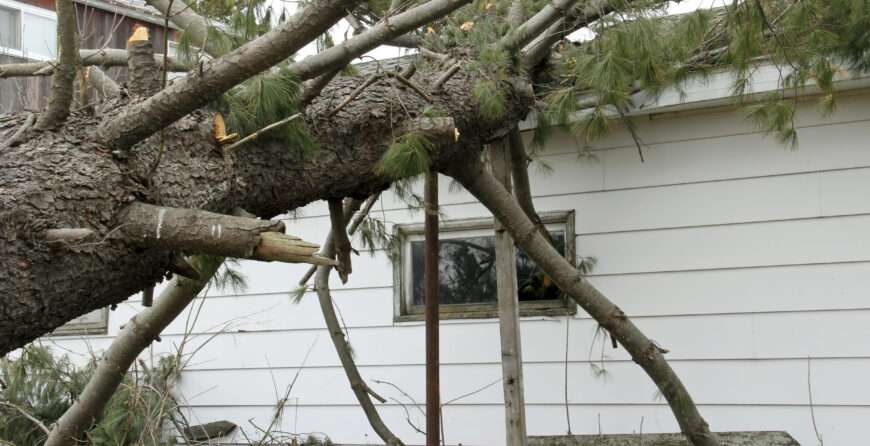Last week, a violent microburst hit parts of Northern Ontario. Winds tore through treetops, snapped trunks like toothpicks, and reminded us all how fast nature can change everything. But there was one property that really stood out—because what fell shouldn’t have been left standing in the first place.
The land had recently been cleared by another company. They left behind several towering 60-foot white pines. At first glance, it looked like a smart choice. Keep the big trees, preserve the beauty. But when the storm came, those trees were the first to go down, ripping up massive root plates and crashing into the cleared ground. There were no buildings nearby, thankfully—but if there had been, it would’ve been a total loss.
This happens more often than you’d think. And the reason is simple: full-grown white and red pines that were raised in a forest are not built to stand alone.
Forest-Born Pines Rely on the Crowd
White pine (Pinus strobus) and red pine (Pinus resinosa) are native to Ontario and thrive in dense, tightly packed forests. In that environment, their root systems develop shallow and wide—not deep. According to the Ontario Ministry of Natural Resources, these trees rarely form strong central taproots in real-world soil conditions. Instead, they grow lateral roots close to the surface, depending on neighbouring trees to block wind and stabilize the soil.
Take those neighbouring trees away, and suddenly that big, majestic pine is left standing with a root system that’s just a few inches deep—and no support. It may have stood for 60 years without issue, but that’s only because it was never alone.
Even worse, when you clear around a mature pine, you loosen the soil that used to be held firm by other root networks. That loss of density makes the remaining tree even more unstable. So what you’ve now got is a 60-foot tree, with shallow roots in soft ground, exposed to open wind for the first time in its life.
One storm is all it takes. And that’s exactly what happened.
Some Trees Can Handle Exposure — Pines Usually Can’t
Not all trees behave the same way. Maple trees, like sugar maple and red maple, typically grow deep and widespread roots and can better adapt to new environmental stress. Even if they grew in a mixed forest, they’re more capable of holding their ground when exposed—literally. This is partly because many hardwoods develop strong taproots when young, which continue to stabilize them throughout their life.
But don’t make the mistake of thinking all hardwoods are safe. Birch and poplar are just as dangerous as pines when they reach maturity. These trees grow fast and look solid, but they have brittle wood and weak, shallow root systems, making them highly susceptible to windthrow. Just like a pine, a large birch or poplar left standing alone on a cleared lot is a major risk.
What About Pines That Grew Alone?
Here’s where it gets interesting. White and red pines that grow in open areas from the beginning can actually become stronger, because they adapt over time. When exposed to wind early in their life, they develop broader crowns, denser trunks, and stronger root networks that respond to the environment. The University of Minnesota Extension notes that early exposure leads to more resilient structural growth.
So the issue isn’t the species itself—it’s how the tree was raised. A pine that grew in the open? Likely stable. A pine that spent 40 years surrounded by forest, suddenly left exposed after a clearing job? That’s a future insurance claim.
Clearing Isn’t Just Cutting—It’s Understanding the Land
At Canada Brush Control, we see this all the time. A property gets cleared, the machines roll out, and what’s left behind looks good—until the next big wind hits. That’s why we take a different approach.
As Land Clearing Specialists, we don’t just look at what’s above the ground. We study how each tree grew, what kind of soil it’s in, how its roots are structured, and whether it can handle being left behind. Sometimes, a tree looks healthy but is completely dependent on the forest that once surrounded it.
We always advise homeowners and builders: it’s better to leave smaller, younger trees. These trees will adapt. Their roots will grow in response to their new environment. They’ll shape themselves to the open land and stand strong for decades. A big pine grown in the safety of the forest won’t.
Because every dream build starts with a clean slate. We help uncover it—one tree at a time.
Tips for Safer, Smarter Land Clearing
If you’re planning a build or clearing property in Northern Ontario, here’s what to keep in mind:
- Don’t leave full-grown forest-raised white or red pines standing solo—they’re not adapted to open wind or loose soil.
- Hardwoods like maple are safer to leave if they’re mature and healthy.
- Avoid large birch and poplar—they’re fast-growing, brittle, and weak-rooted.
- Soil structure matters—clearing affects root stability even if you don’t touch the tree itself.
- Smaller trees can adapt—they’ll grow strong in the new conditions if left early.
- Work with a land clearing team that knows more than just how to operate a machine.
At Canada Brush Control, we combine strategy with experience. We don’t just create open space—we make sure what’s left behind is safe, stable, and built to last.


